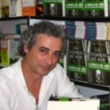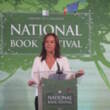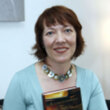The prisoner of heaven: a novel
Description
“Gabriel García Márquez meets Umberto Eco meets Jorge Luis Borges for a sprawling magic show." —New York Times Book Review on Shadow of the Wind
More Details
Kenny, Peter narrator., nrt, Narrator
Ruiz Zafon, Carlos Author
Ruiz Zafón, Carlos Author
9780062208613
9780062209030
9780062206305
9781443413794
Similar Series From Novelist
Similar Titles From NoveList
Similar Authors From NoveList
Published Reviews
Booklist Review
In the third novel of the Cemetery of Forgotten Books series, Zafon takes us to Sempere & Sons bookshop in 1950s Barcelona. Here, a mystery unfolds involving Fermin the sarcastic, yet lovable, store clerk and a grim, intimidating stranger who arrives one day searching for him. Soon it becomes necessary for Fermin to tell the truth about his mysterious past, and the novel flashes back to a dank, crowded prison following the end of the Spanish Civil War. While the reader should not expect many shocking plot twists, the story is gripping and the pace is just right. Further, the magic of the novel is in the wonderfully constructed creepy and otherworldly setting, the likable characters, and the near-perfect dialogue. Throw in ample references to The Count of Monte Cristo, a bit of revenge, an insane author, patronage politics, and more than one Fascist, and you have an entertaining and quietly suspenseful yarn. Please note that it is not necessary to read the novels of this series in any particular order.--Price, Kerri Copyright 2010 Booklist
Publisher's Weekly Review
Characters from The Shadow of the Wind and The Angel's Game reconvene in Zafon's newest literary thriller. When a stranger shows up at the struggling Sempere & Sons bookshop in Barcelona in 1957 to buy a rare and expensive volume, Daniel Sempere-the son-sets out to uncover the mysterious man's motives. The resulting mix of history and mystery drives this third installment in Zafon's cycle about the Cemetery of Forgotten Books, a "sprawling labyrinth.like the trunk of an endless tree." What Daniel discovers will implicate those he loves, has lost, and loathes-from his soon-to-be-wed friend, Fermín; to Daniel's mother, Isabella, who died under questionable circumstances; his father; his wife, Bea, and infant son, Julian; and a host of schemers, torturers, corrupt governmental officials, writers, and lovers, many of whom have changed identities, hurriedly penned secret missives, and stashed keys to hidden treasures. Zafon's storytelling is deft and well-paced, and his vivid prose brings the cultural riches and political strife of Franco-era Spain to life. Though the book will undoubtedly please readers familiar with his other novels, as the introduction explains, the book is a "self-contained tale" capable of standing alone-something it does with aplomb. (July) © Copyright PWxyz, LLC. All rights reserved.
Library Journal Review
In this third installment of Zafon's "Cemetery of Forgotten Books" quartet (The Shadow of the Wind; The Angel's Game), readers journey to 1950s Barcelona, where Daniel Sempere and his wife, Bea, are celebrating their new son and their close friend Fermin is about to be married. But a stranger's visit to Daniel's bookshop threatens to expose secrets that go back to the early days of Franco's dictatorship. Focusing on the mysterious background of the charismatic Fermin, the novel pulls readers into the horrific conditions of a 1940s prison as it discloses the secrets that are coming back to haunt him. While the abrupt ending may initially disappoint some fans, the promise of a fourth book that will pull together all the story lines is a welcome one. Verdict The gorgeous language and complex relationships in this gothic adventure reflect the high level of writing readers have come to expect from Zafon. This darkly intriguing read is highly recommended for series fans and aficionados of gothic fiction. [See Prepub Alert, 2/27/12.]-Katie Lawrence, Chicago (c) Copyright 2012. Library Journals LLC, a wholly owned subsidiary of Media Source, Inc. No redistribution permitted.
Kirkus Book Review
The Count of Monte Cristo finds justice--after a fashion, anyway, and by the most roundabout of routes. Daniel Sempere leads a life of bookish desperation in a Barcelona still reeling from the years of the Franco dictatorship. His father is even more desperate; no one is buying his wares, and there are always bills to pay. It's with considerable if very temporary relief that, while his father is away from their bookshop, Daniel sells a rare copy of The Count of Monte Cristo to a shadowy stranger who uses it to send a message to a helper in the store: "For Fermn Romero de Torres, who came back from among the dead and holds the key to the future." Who is the stranger, and what does his dark message mean? Will Daniel's long-suffering wife run off, leaving the book retailer for a book publisher? Will anyone in our time read Dumas pre's book without having to be assigned to do so? For that matter, why did Franco ban Dumas, and what kind of trouble is Daniel in for because he has a copy for sale? From those promising if murky beginnings, Ruiz Zafn's story takes off, resembling a Poe story here, a dark Lovecraft fantasy there, a sunny Christopher Morley yarn over there. The influences of those authors, to say nothing of Dumas and Balzac, are everywhere, though it's a little disconcerting to find a street girl talking like Oliver Twist: "It's me tits....A joy to look at, aren't they, even though I shouldn't say so." But Ruiz Zafn's story soon takes twists into the fantastic and metaphorical, heading underground literally and figuratively, to places such as the Cemetery of Forgotten Books, a place that only good and diligent readers ever get to visit, and in which the solution to the mystery is lain. Ruiz Zafn narrowly avoids preciousness, and the ghosts of Spain that turn up around every corner are real enough. Readers are likely to get a kick out of this improbable, oddly entertaining allegory.]] Copyright Kirkus Reviews, used with permission.
Booklist Reviews
In the third novel of the Cemetery of Forgotten Books series, Zafón takes us to Sempere & Sons bookshop in 1950s Barcelona. Here, a mystery unfolds involving Fermín—the sarcastic, yet lovable, store clerk—and a grim, intimidating stranger who arrives one day searching for him. Soon it becomes necessary for Fermín to tell the truth about his mysterious past, and the novel flashes back to a dank, crowded prison following the end of the Spanish Civil War. While the reader should not expect many shocking plot twists, the story is gripping and the pace is just right. Further, the magic of the novel is in the wonderfully constructed creepy and otherworldly setting, the likable characters, and the near-perfect dialogue. Throw in ample references to The Count of Monte Cristo, a bit of revenge, an insane author, patronage politics, and more than one Fascist, and you have an entertaining and quietly suspenseful yarn. Please note that it is not necessary to read the novels of this series in any particular order. Copyright 2012 Booklist Reviews.
Library Journal Reviews
As entertainingly twisted as Gaudi's architecture, only darker, Zafón's best-selling fiction (e.g., The Shadow of the Wind) inhabits a distinctive Barcelona. At Christmas in 1957, Daniel Sempere and his wife are enjoying their new son and the prospect of their friend Fermín's marriage when a stranger arrives at their bookshop, prepared to reveal a dark secret harking back to Franco's early days. With a 200,000-copy first printing and a seven-city tour to Boston, Los Angeles, New York, San Francisco, Seattle, Portland, and Washington, DC; don't miss. - "Mantel to Zafón " LJ Reviews 3/1/2012 (c) Copyright 2011. Library Journals LLC, a wholly owned subsidiary of Media Source, Inc. No redistribution permitted.
LJ Express Reviews
Cohen's (Where To Take Tea: A Guide To Britain's Best Tearooms) guide to London teahouses is as bright and lovely as many of the locations she describes. Over 30 teahouses are given a one- to two-page treatment, including descriptions of the types of teas offered and the general atmosphere. Special note is made when certain teas require reservations, or if there are days when certain teahouses are usually busier than others. The teahouses appear alphabetically; a useful map at the front of the book helps those looking for tea by location rather than name. Each teahouse's important information is listed, including set teas, contact information, and nearby sites and Underground stations. A short collection of recipes at the end allows those of us with no London travel plans in the future to get a taste of London tea at home. The only shortcoming to this otherwise lovely guide is that some teahouses are listed by the hotel they are located in rather then by their proper names. Verdict An excellent addition for anyone traveling to London or with a particular interest in tea.—Sara Miller, Atlanta-Fulton P.L. Syst. (c) Copyright 2010. Library Journals LLC, a wholly owned subsidiary of Media Source, Inc. No redistribution permitted.
Publishers Weekly Reviews
Characters from The Shadow of the Wind and The Angel's Game reconvene in Zafón's newest literary thriller. When a stranger shows up at the struggling Sempere & Sons bookshop in Barcelona in 1957 to buy a rare and expensive volume, Daniel Sempere—the son—sets out to uncover the mysterious man's motives. The resulting mix of history and mystery drives this third installment in Zafón's cycle about the Cemetery of Forgotten Books, a "sprawling labyrinth…like the trunk of an endless tree." What Daniel discovers will implicate those he loves, has lost, and loathes—from his soon-to-be-wed friend, Fermín; to Daniel's mother, Isabella, who died under questionable circumstances; his father; his wife, Bea, and infant son, Julian; and a host of schemers, torturers, corrupt governmental officials, writers, and lovers, many of whom have changed identities, hurriedly penned secret missives, and stashed keys to hidden treasures. Zafón's storytelling is deft and well-paced, and his vivid prose brings the cultural riches and political strife of Franco-era Spain to life. Though the book will undoubtedly please readers familiar with his other novels, as the introduction explains, the book is a "self-contained tale" capable of standing alone—something it does with aplomb. (July)
[Page ]. Copyright 2012 PWxyz LLCPW Annex Reviews
Characters from The Shadow of the Wind and The Angel's Game reconvene in Zafón's newest literary thriller. When a stranger shows up at the struggling Sempere & Sons bookshop in Barcelona in 1957 to buy a rare and expensive volume, Daniel Sempere—the son—sets out to uncover the mysterious man's motives. The resulting mix of history and mystery drives this third installment in Zafón's cycle about the Cemetery of Forgotten Books, a "sprawling labyrinth…like the trunk of an endless tree." What Daniel discovers will implicate those he loves, has lost, and loathes—from his soon-to-be-wed friend, Fermín; to Daniel's mother, Isabella, who died under questionable circumstances; his father; his wife, Bea, and infant son, Julian; and a host of schemers, torturers, corrupt governmental officials, writers, and lovers, many of whom have changed identities, hurriedly penned secret missives, and stashed keys to hidden treasures. Zafón's storytelling is deft and well-paced, and his vivid prose brings the cultural riches and political strife of Franco-era Spain to life. Though the book will undoubtedly please readers familiar with his other novels, as the introduction explains, the book is a "self-contained tale" capable of standing alone—something it does with aplomb. (July)
[Page ]. Copyright 2012 PWxyz LLC






































